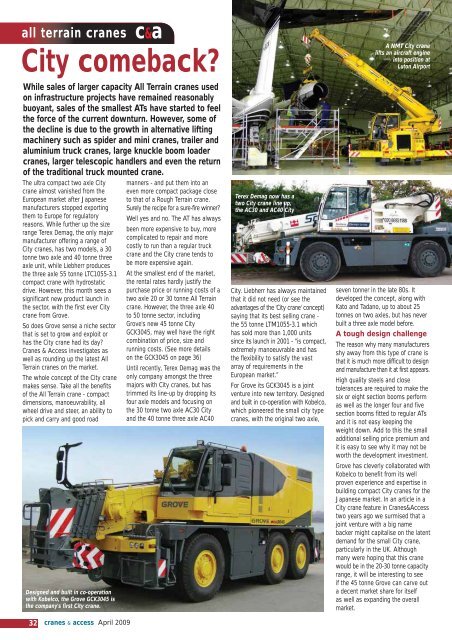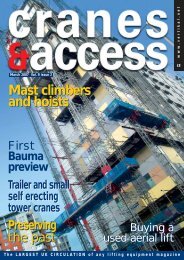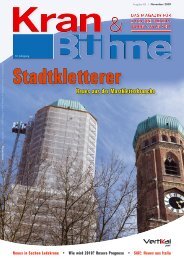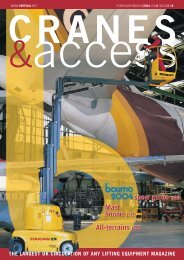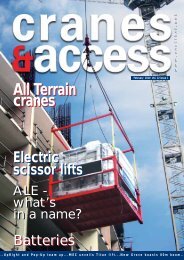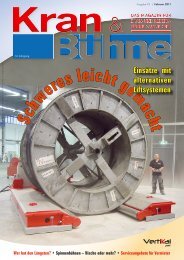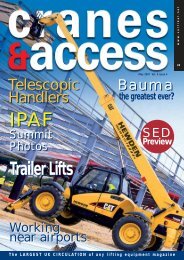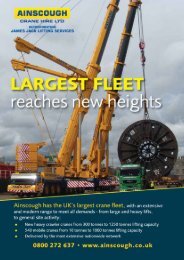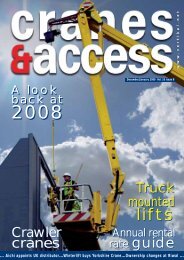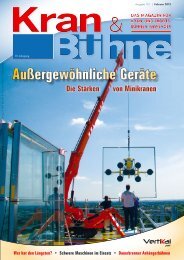Create successful ePaper yourself
Turn your PDF publications into a flip-book with our unique Google optimized e-Paper software.
all terrain cranes c&a<br />
City comeback?<br />
While sales of larger capacity All Terrain cranes used<br />
on infrastructure projects have remained reasonably<br />
buoyant, sales of the smallest ATs have started to feel<br />
the force of the current downturn. However, some of<br />
the decline is due to the growth in alternative lifting<br />
machinery such as spider and mini cranes, trailer and<br />
aluminium truck cranes, large knuckle boom loader<br />
cranes, larger telescopic handlers and even the return<br />
of the traditional truck mounted crane.<br />
The ultra compact two axle City<br />
crane almost vanished from the<br />
European market after Japanese<br />
manufacturers stopped exporting<br />
them to Europe for regulatory<br />
reasons. While further up the size<br />
range Terex Demag, the only major<br />
manufacturer offering a range of<br />
City cranes, has two models, a 30<br />
tonne two axle and 40 tonne three<br />
axle unit, while Liebherr produces<br />
the three axle 55 tonne LTC1055-3.1<br />
compact crane with hydrostatic<br />
drive. However, this month sees a<br />
significant new product launch in<br />
the sector, with the first ever City<br />
crane from Grove.<br />
So does Grove sense a niche sector<br />
that is set to grow and exploit or<br />
has the City crane had its day?<br />
Cranes & Access investigates as<br />
well as rounding up the latest All<br />
Terrain cranes on the market.<br />
The whole concept of the City crane<br />
makes sense. Take all the benefits<br />
of the All Terrain crane - compact<br />
dimensions, manoeuvrability, all<br />
wheel drive and steer, an ability to<br />
pick and carry and good road<br />
Designed and built in co-operation<br />
with Kobelco, the Grove GCK3045 is<br />
the company's first City crane.<br />
32 cranes & access April 2009<br />
manners - and put them into an<br />
even more compact package close<br />
to that of a Rough Terrain crane.<br />
Surely the recipe for a sure-fire winner?<br />
Well yes and no. The AT has always<br />
been more expensive to buy, more<br />
complicated to repair and more<br />
costly to run than a regular truck<br />
crane and the City crane tends to<br />
be more expensive again.<br />
At the smallest end of the market,<br />
the rental rates hardly justify the<br />
purchase price or running costs of a<br />
two axle 20 or 30 tonne All Terrain<br />
crane. However, the three axle 40<br />
to 50 tonne sector, including<br />
Grove's new 45 tonne City<br />
GCK3045, may well have the right<br />
combination of price, size and<br />
running costs. (See more details<br />
on the GCK3045 on page 36)<br />
Until recently, Terex Demag was the<br />
only company amongst the three<br />
majors with City cranes, but has<br />
trimmed its line-up by dropping its<br />
four axle models and focusing on<br />
the 30 tonne two axle AC30 City<br />
and the 40 tonne three axle AC40<br />
Terex Demag now has a<br />
two City crane line up,<br />
the AC30 and AC40 City<br />
City. Liebherr has always maintained<br />
that it did not need (or see the<br />
advantages of the 'City crane' concept)<br />
saying that its best selling crane -<br />
the 55 tonne LTM1055-3.1 which<br />
has sold more than 1,000 units<br />
since its launch in 2001 - “is compact,<br />
extremely manoeuvrable and has<br />
the flexibility to satisfy the vast<br />
array of requirements in the<br />
European market.”<br />
For Grove its GCK3045 is a joint<br />
venture into new territory. Designed<br />
and built in co-operation with Kobelco,<br />
which pioneered the small city type<br />
cranes, with the original two axle,<br />
A NMT City crane<br />
lifts an aircraft engine<br />
into position at<br />
Luton Airport<br />
seven tonner in the late 80s. It<br />
developed the concept, along with<br />
Kato and Tadano, up to about 25<br />
tonnes on two axles, but has never<br />
built a three axle model before.<br />
A tough design challenge<br />
The reason why many manufacturers<br />
shy away from this type of crane is<br />
that it is much more difficult to design<br />
and manufacture than it at first appears.<br />
High quality steels and close<br />
tolerances are required to make the<br />
six or eight section <strong>booms</strong> perform<br />
as well as the longer four and five<br />
section <strong>booms</strong> fitted to regular ATs<br />
and it is not easy keeping the<br />
weight down. Add to this the small<br />
additional selling price premium and<br />
it is easy to see why it may not be<br />
worth the development investment.<br />
Grove has cleverly collaborated with<br />
Kobelco to benefit from its well<br />
proven experience and expertise in<br />
building compact City cranes for the<br />
Japanese market. In an article in a<br />
City crane feature in Cranes&Access<br />
two years ago we surmised that a<br />
joint venture with a big name<br />
backer might capitalise on the latent<br />
demand for the small City crane,<br />
particularly in the UK. Although<br />
many were hoping that this crane<br />
would be in the 20-30 tonne capacity<br />
range, it will be interesting to see<br />
if the 45 tonne Grove can carve out<br />
a decent market share for itself<br />
as well as expanding the overall<br />
market.


